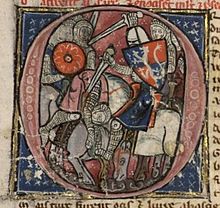Chanson d'Antioche
The Chanson d'Antioche (not to be confused with the Occitan Canso d'Antioch of Grégoire Béchada ) is a chanson de geste consisting of 9000 lines in laisses called strophic , which in 1180 for a courtly French was written audience. It is one of two quasi-historical cycles of epic poems that were inspired by the events of 1097-1099, the First Crusade : the conquest of Antioch and Jerusalem and the origins of the Crusader states . A second chanson dealing with Godfrey of Bouillon is the Chanson de Jerusalem . In the 14th century another cycle was created, more fabulous and embellished, clearly more romance than epic.
The themes of the chanson are the sermons for the First Crusade, the preparations for the departure, the tearful farewell, the arrival in Constantinople and the siege and conquest of Antioch .
The lost original poem is said to have been written by an eyewitness, Richard le Pélerin ("Richard the Pilgrim"), a northern French or Flemish troubadour who started it partly on site during the eight-month siege of Antioch. It was later redesigned by Graindor de Douai, a contemporary of Louis VII , who added details from the Chronicles to make his work more vivid and accurate, and whose aim from the beginning was to tell the true and laudable story:
- Seignor, oïés canchon, qui moult fait à loer
- Par itel convenant la vos puis-je conter ...
- Je ne vous vorrai mie mensonges raconter
- Ne fables, ne paroles pour vos deniers embler
- Ains vous dirai canchon où il n'a hamender
- Del barnage de Franche qui tant fait à loer!
This right to tell the truth is part of the poet's epic repertoire. Exaggeration and epic listings are other main means in this chanson: the poet makes sure that every chivalric name is mentioned in order to create a sense of recognition among his listeners, a tradition as old as Homer , with the result that that Chanson d'Antioche was considered a verbatim document by the heralds and genealogists of later generations and won the respect of historians.
Crusade cycles had a large audience in the Middle Ages : free translations and versions of the Chanson d'Antioche can be found in Spanish , English , Dutch and German .
The Chanson d'Antioche was forgotten until it was printed and published by Paulin Paris in 1848 in the heyday of Romanticism . The current edition of the epic is that by Suzanne Duparc-Quioc, Paris 1977.
literature
- Anouar Hatem: Les poèmes épiques des croisades. Essai sur l'activité littéraire dans les colonies franques de Syrie au moyen age; genèse, historicité, localization. Slatkine Repr., Genève 1973.
- Susan Edgington, Carol Sweetenham (Eds.): The Chanson d'Antioche. An Old French Account of the First Crusade . (= Crusade Texts in Translation. 22). Farnham et al. 2011, ISBN 978-0-7546-5489-6 .
Web links
- Levine, The Betrayal and Capture of Antioch , laisses CCXXX – CCLXV (English)
